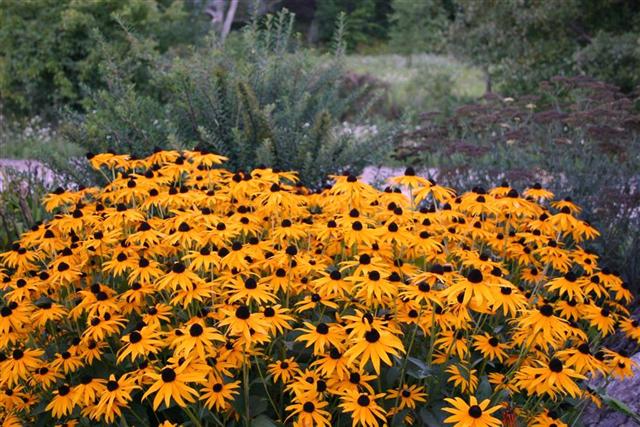Surprisingly, nobody has said anything yet. Look all around on campus, in all the new plantings, and you’ll see Black Eyed Susan, Rudbeckia fulgida var. sullivantii ‘Goldsturm’. I’m waiting for the question, What’s with all these Black Eyed Susans anyway?
Horticulturists dream of fame and glory, just like the rest of you. It’s a little harder for us, naturally, having our head in the clouds most of the time, paying attention to this little flower, that tree, the smell of good compost, but we can dream too.
Imagine being a German horticulturist, say about 1937. Your name is Heinrich Hagemann, and you are walking through Gebrueder Schuetz’s nursery in the Czech Republic. You see a stand of Black Eyed Susan, a rather pedestrian flower to some flower snob friends of yours, but you’ve always had a soft spot for it. Something catches your eye, though, and you bend over and take a closer look.
Brighter color, certainly, and a huge mass of flowers on top, but look at the growth. It seems more compact than the normal species, much tighter and fuller, not ‘flopsy’ (a true horticultural term, though I don’t know the German). Lustrous dark green leaves, rich and full, not pale and insignificant like the species. Giddy, but refusing to show it, you meekly ask about the plant. Oh yes, they say, it’s been around for a couple of years now, it blooms from the end of July until October. Real clumpy too, forms an impenetrable mat of foliage, weeds don’t seem to grow through it.
You take some seeds home with you, as it comes true to seed, and convince your employer Karl Foerster in Potsdam, Germany to propagate it. (You don’t know it yet, but he’s writing a book called Einzag der Graeser and Fame die Gaerten (The Use of Grasses and Ferns in the Garden), where he’ll introduce a Feather Reed Grass, Calamagrostis xacutiflora ‘Karl Foerster’. One story at a time.) World War II interferes, and you don’t release your new plant until 1949, under the name ‘Goldstrum’ (Gold Storm), after the copious flowers in that rich gold with the black center that so caught your eye. Maybe not fame and fortune, but certainly a successful business insues.
Perfectly hardy in both the heat of the deep south as well as the cold of Canada, Goldstrum Black Eyed Susan is the Perennial Plant Associations’ 1999 Perennial Plant of the Year. (The source for my imaginary musing above…)Blooming now in my yard and on campus at about 32″ tall, it gently spreads in unused areas of my garden, its dark green leaves staying tidy and dark green until the show of flowers.
And what a show. Here’s one of the reasons why it’s on campus. The start of the bloom cycle was the beginning of August, right in the heart of Language School. It will still be in full, glorious bloom for student move in, end of August, Parent’s weekend, and, in the right year, some of the blooms will still be around for Homecoming, end of September/beginning of October. That’s a lot to ask of most plants. But to be low maintenance as well, be a hybrid of a native, and to stay tidy and compact in a landscape? Heinrich had a hell of an eye.
Goldstrum enjoys full sun, but can tolerate a surprising amount of shade for something in the Asteraceae family, up to only 3-4 hours of sun. Some years it seems a little shorter, but with all the rain this year it must have outgrown the height listed in most catalogs (18-30″). It comes true from seed, although it is claimed that it may vary more in size that way. I space them when planting at about 24″, and they fill in after a quick couple of years.
So look around campus, and notice the clumps everywhere. Middlebury College has few actual landscape beds, and most of them are small compared to the buildings, the land, and certainly the view. In all landscapes, I find it useful to repeat something, most often a plant, that will tie different beds together to make the landscaping more cohesive. Rather than overwhelming the eye, repetition gives the viewer a rest, a little pause button that makes other parts stand out just a bit more. And repeating a plant that blooms for almost 3 months seems almost like cheating. But the low maintenance seals the deal. Anything that is non-invasive, but forms a weed-free mat is good in my book (and the guys on our crew). At my house I leave the dead stalks up all winter for interest in stick season, but your results may vary.
The real reason Middlebury is awash in Black Eyed Susan? It’s my wife’s favorite flower. Don’t tell my boss.


You must be logged in to post a comment.